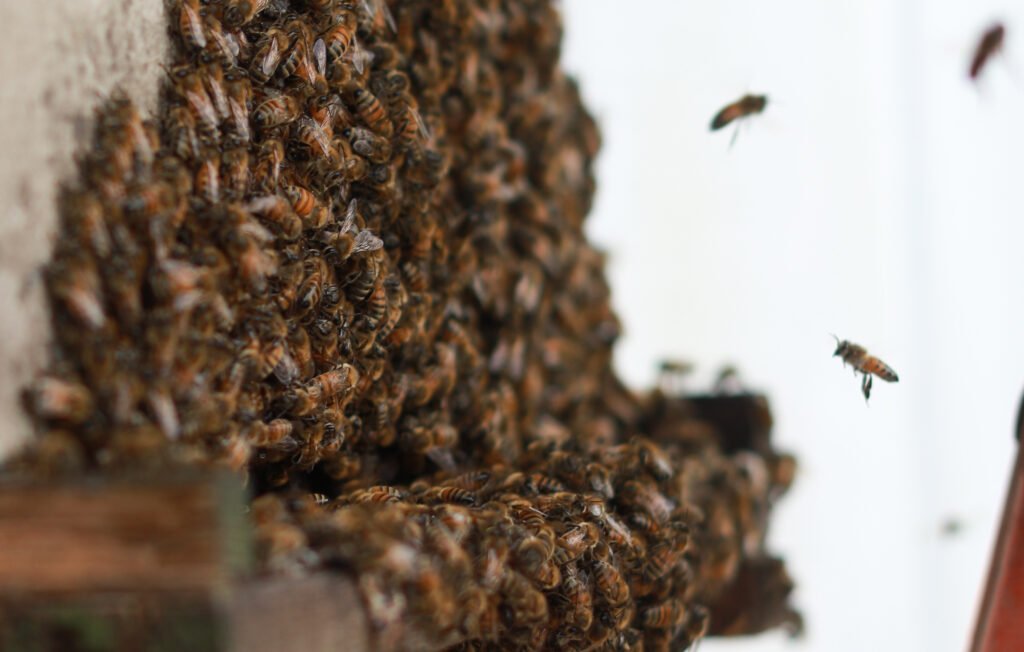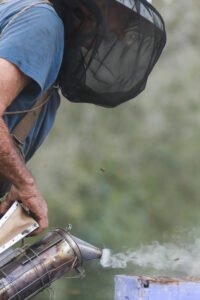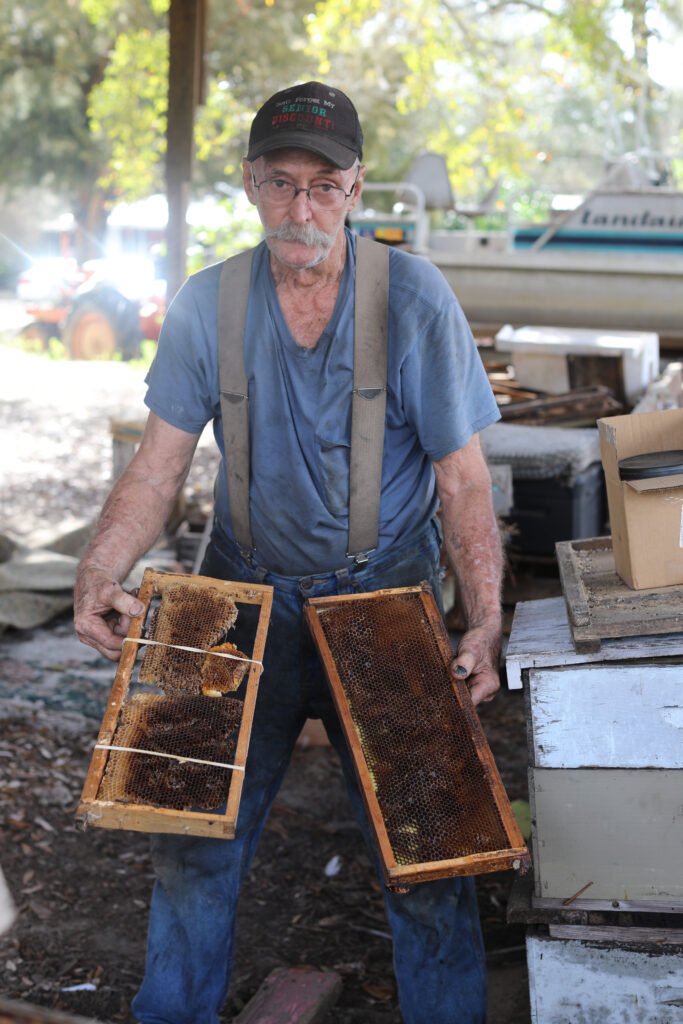
Honey bee populations are making a comeback amid serious challenges
Story By Carlton Reese
Photography by Ralph Demilio
The perfect monarchy, so long a quest of humankind never coming to fruition, has existed since long before the first spear impaled a wooly mammoth. Where man has failed, the honey bee has forged countless empires with monuments to its efficiency constructed on every habitable continent of this planet.
With selfless dedication to queen and colony – attributes more suited to the six-legged creatures among us than the contumacious hominids – honey bees provide a template of consummate organization, cooperation and production. These colonies, so prevalent in Florida and especially Marion County, exist not just to satisfy a long-lived queen or to dominate a world that fears its sting but to provide perhaps the most significant link in the chain of human agriculture.
Most everything humans consume derives directly or indirectly from the realm of the honey bee, which is why any news of a potential demise of these creatures sends waves of apoplexy throughout the public. The headlines create a picture of crisis with a desperate call to action in tow:
“Bee populations declining drastically!”
– WION, August 2020
“Study: Global Bee Populations in Decline”
– Public News Service, January 2021
“Nearly 40% decline in honey bee population last winter ‘unsustainable,’ experts say”
– ABC News, July 2019
From a population of 6 million U.S. hives in 1947 down to just 2.4 million in 2008, the headlines and alarm bells rang rather loudly as to the impending doom if the trend were to continue. The biggest problems causing the decline seem to have been various types of mites and hive beetles while speculation that man-made pesticides have played a role certainly has traction.
Despite the mites, beetles, pesticides and the mysterious Colony Collapse Disorder that ravaged the bee world in the mid-late 2000s, the numbers are now trending in the right direction as honey bees are making a comeback. The seemingly-imminent bee apocalypse feared by so many seems to be a more fortunate tale where all can more easily breathe a sigh of relief.
After all, it appears the bees have two strong allies in their fight: human beings and the bees themselves.
One of those humans helping the bee populations locally is Calvin Benjamin, who at age 80 is called upon by the Marion County UF/IFAS Extension for bee rescues. He says the volume of bee rescue missions keeps going up and predicts he will conduct over 100 rescues this year in The Villages alone.
“The native bee has adapted to stay healthy,” Benjamin says of the local honey bees which aren’t technically native, but brought to America from Europe in the 1600s. “The commercial guys had a lot of problems with the mites, but the strong hives didn’t seem to have too much of a problem.”
In Florida alone, the number of registered beekeepers has increased about 10-fold over the last decade and with that explosion has been the subsequent increase in the bee population itself. These numbers don’t even reflect the bees in the wild or those residing at un-registered locations. It is estimated that there are over 650,000 honey bee colonies in Florida, which ranks behind only North Dakota and South Dakota in honey production.
A bee colony report by the United States Department of Agriculture noted an increase in the number of colonies by 14 percent nationwide from 2019 to 2020.
All this is good news, but the numbers are still far below where they stood in the mid-20th century. It would not take much to reverse this positive trend.

“Last year when we had a drought, everybody I knew lost half their bees,” said Dale Claytor who operates hives and conducts bee rescues in north Ocala. “I believe we are going in the right direction and slowly making progress, but it wouldn’t take much to have a setback if we got some new disease or something like that.”
Because three out of four crops in Florida are estimated to be pollinated by honey bees, their well-being directly correlates to the physical and economic well-being of its citizens. Crops that remain heavily reliant on honey bee pollination include strawberries, blueberries, squash, watermelon and numerous other staples.
Through his rescues, Benjamin has accumulated over 100 hives – he started with just one about six years ago – that produce around 10,000 pounds of honey. One of the keys is to send the hives to where the resources are, which means taking them to different counties at different times of the year depending on which crops are viable for bee populations. He refers to this process as “migrating locally” as opposed to what the large, commercial beekeepers practice in sending their bees all over the country.
“We’re still trying to figure it out,” said Benjamin, who is sending hives to Steinhatchee in the Florida Big Bend region soon. “There, we’ll get tupelo honey and this stuff is fantastic. It’s high-dollar honey, but it’s only about two months of the year then we’ll move the bees somewhere else where there is another crop.”
One problem obtaining an accurate count of bees is the migratory nature of the business. Today, most of the money made by large commercial beekeepers is in shipping bees to large growers across the country. This means sending large quantities of bees to California for pollination of almond groves or to Michigan for pollination of cranberries. Upon return back to Florida, there is always a significant depletion in the number of bees, which have not died but merely swarmed in those areas.
“If they weren’t shipping bees all over the country like that and counting those bees as losses, I think we would have a better bee population,” Claytor said. “In the state of Florida, you’re required to register your bees whether you have one hive or a thousand, and I know a lot of beekeepers out there that don’t register their bees so those aren’t counted in the statistics.”
Benjamin and Claytor are a microcosm of the upward tick in the bee industry. Both have seen firsthand the positive surge in bee populations not only in the expansion of their own hive collections but in their rescue missions as well.
“I know right now bees are doing pretty well in Florida,” Benjamin says during a recent extraction of a large hive on Bird Island. “With the calls I get, I think the bee population is pretty strong.”
Benjamin’s first initiation with bees came as child with his grandfather back in Vermont. He moved to Florida in the 1980s and six years ago made beekeeping and rescuing a full-time endeavor. In growing his hive count from one to 100 he has also seen the volume of his bee rescue missions increase dramatically.
It started out as just a hobby, but Benjamin is now the main go-to guy for the county when it comes to bee rescue. He has become an expert on the subject and his observations have helped shape an opinion on how these insects can best thrive.
“I find the native bees (as opposed to commercially bred bees) to be a lot more docile, cleaner and in better shape. They’ve got it down where they know how to survive – the bees that you bring in and the queens you buy are not always that good.”

Claytor certainly concurs with that sentiment, stating, “My observation is that those swarm queens are more vibrant than those domestic queens. The swarm queens outperform as far as laying (eggs) and producing bees than the domesticated ones.” He notes that the state requires beekeepers who catch queens that swarm are to kill them as opposed to setting up hives with them, but that is not always the best policy.
The fear of Africanized bees, known commonly as “killer bees” for their aggressive nature, has encouraged this policy, but Claytor says this far north sightings are extremely rare if any at all. To be certain, when he captures a queen, he constantly observes the hive for any unusually aggressive behavior, but so far he has not come across any that would suggest Africanized bees in these parts.
Claytor’s foray into beekeeping and rescue started as a simple desire to produce his own honey for green tea he drank. Maintaining a few hives whet his appetite for more knowledge on the subject and he has since been through the University of Florida’s master beekeeper program and started his own club, Backyard Beekeepers.
On a recent rescue in Silver Springs Shores, Claytor came upon a monster hive as proof honey bees are thriving in the wild here. From an old shed he discovered a hive beneath the floor that measured 10 feet by 2 feet with approximately 300,000 bees – all at the service of one hardworking queen.
“It was the most perfect rectangle, about a foot deep and three inches thick – just a beautiful honeycomb. All the way back it had nothing but brood and eggs and bees. That was the most adventurous one I’ve had.”
Local beekeepers such as Benjamin and Claytor serve as the human element to maintaining and expanding bee populations; the rest has been up to the bees themselves which have had to overcome numerous threats thrown at them from nature and man. Since their peak populations in the 1940s, bees have had to battle mainly the varroa mite, which burrows into bees and can cause major depletions, and hive beetles that prey easily on weaker hives. Thanks to their natural adaptive capabilities, bees have been able to stave off these predators along with the help of human maintenance.
There have been fears recently of those Africanized bees and of large “murder hornets,” but neither has been relevant in Florida up to now.
The issue of pesticides, particularly neonicotinoids, presents a much more complex problem. Still a debate among experts as to the level of damage caused by these chemicals to pollinators, beekeepers on the whole are more than just wary of their close proximities to hives.
“They will kill a hive,” Benjamin says of insecticides. “If it gets into the honey, the bees will feed that back to the young, the young die and the hive dies.
“The genetic corn that has natural insecticide in it, it doesn’t just kill bees, it kills all insects. So that’s one of the worst things that’s happened. The corn is okay, but everything else suffers.”
While neonicotinoids have been largely banned in Europe due mainly to the effect on honey bees, the U.S. Environmental Protection Agency has ruled out banning the chemicals while instituting certain protections and management procedures. Claytor says he is confident that beekeepers can avoid harmful pesticides and that registering the bees is part of the protection.
“In the state of Florida, one of the reasons you want to register your bees is because you go into the (Department of Transportation) database,” Claytor explained. “When the DOT goes out and sprays for mosquitoes and other pests, if you’re in that database they will not spray in your area.
“The state, and the government as a whole, is very well aware of what is going on with bees and has been very supportive.”

As for Colony Collapse Disorder, in which whole hives disappear seemingly overnight without a trace, no real answers have come forth. Theories range from the aforementioned mites, diseases and chemical toxins in the environment to unknown pests and poor genetic diversity. Benjamin and Claytor have their hypotheses as well:
“Bad beekeeping,” claims Benjamin for CCD. “I don’t have any trouble with it. I deal with mostly native bees and they’ve learned to take care of themselves.”
“From my own personal observations, it seems to do with resource availability,” says Claytor. “When we were losing bees last spring, we were constantly discussing it. When a whole hive just gets up and leaves, that’s not predators or anything like that coming in there and destroying them; these bees left for a reason. They’re probably looking for resources.”
The bees need the resources and the resources need the bees, which have shown remarkable abilities to adapt to even the direst of circumstances thrown at them. But as the bees go, so do the fruits and vegetables in this most vital link in the chain of agricultural production and so far it seems the future looks good thanks to their remarkable resiliency.
From the large commercial beekeepers to the bee hobbyist, attention has heightened in this industry which exists not merely as an economic engine but for human survival itself.






